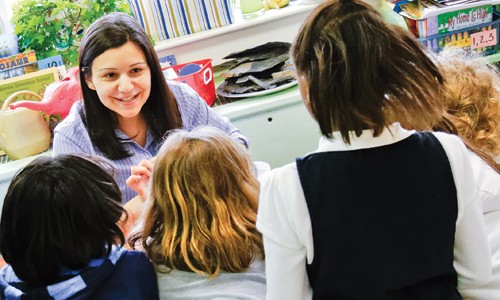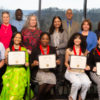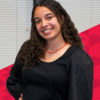Real-World Teaching

Posted by: admin on April 14, 2011, No Comments
Students who are learning to be teachers enter local classrooms as part of a learning community in ESU’s Professional Development Schools Program are at the forefront of a growing national trend.
A professional development school is a partnership between a university’s teacher education programs and local schools, and provides graduates with a distinct advantage when heading into a tight job market.
“Our teacher candidates spend a great deal more time in classrooms learning alongside master teachers than the ‘typical’ student teaching experience,” says Dr. Pat Pinciotti, special assistant to the dean for ESU’s elementary education PDS program. While there are also PDS relationships in the university’s special education, secondary education, and health and physical education departments, the elementary program is the largest and most comprehensive.
The year-long student experience in a Professional Development School includes two consecutive days each week as an apprentice in a local classroom, working alongside a master teacher for one semester. This means the ESU apprentice teachers already have about 150 hours of school experience before returning to the same classroom for one half of their student teaching semester.
“My PDS experience was an eye-opener into the true teaching profession,” says Carrie Fisher ’11, who completed her student teaching work this spring, working with teacher Ann Horvath at Ramsey Elementary School in Stroudsburg.
“I was able to see how a full day happens,” said Fisher, who graduated in May with a bachelor of science degree in elementary education. “In prior experiences, I would come in and teach one solitary lesson but through this experience I was able to teach consecutive lessons and see changes in the students’ understanding of the concept being taught.”
Traditional short-term student teaching programs can leave student teachers feeling like guests in the classroom, with little opportunity for involvement or input. The year-long PDS relationship combines the resources of the university and schools to create a new culture that spans old boundaries, driven by student needs.
“They become an integral part of the life of our school and an important presence in the lives of our students,” says Mary Bowers, a Ramsey Elementary teacher. “It is wonderful to have future professionals who are blending the concepts learned in the classroom at ESU with the classroom of primary age students.”
Fisher appreciated the chance to work with the same class for a full school year, and to see the changes in those students from the beginning of the year to the end “It is remarkable, especially when you think how you made a difference in that child’s life by working with them,” she said.
“Having been an elementary school principal, I clearly see the difference in preparation,” says Dr. Andrew Whitehead, chair of the Department of Early Childhood Education. “Our students are better prepared for the challenge of the classroom. Our candidates have the professional edge and principals can see that.”
This extra time in the classroom also is giving ESU graduates an edge when they look for teaching jobs after graduation.
“They often look more like second-year teachers in their first position, confident and competent,” Pinciotti says, noting that PDS graduates gain strong planning and assessment skills, have better classroom management, incorporate more strategies to reach students from diverse backgrounds and abilities, and find ways to provide more meaningful, integrated learning.
“I have seen the PDS program aid in the development of a more professional, refined and confident teacher,” says Gail Kulick ’88, principal of Resica Elementary School in the East Stroudsburg School District.
The program gives prospective teachers the opportunity to “try out” different strategies, and then to refine their skills during student teaching. In a job interview, ESU graduates stand apart with the extent of their experience.
“Our students are often offered jobs on the spot at job fairs across the country, because they know the rigor of the PDS experience and the quality teacher this produces,” says Pinciotti. “Yes, there are challenges in this economy … but if there is a job … our ESU students are at the front of the line.”
ESU’s Professional Development School program began in 1999 as an option for students. As of fall 2003, all students intending to be certified in elementary education K-6th grade must participate in the two-semester program. Pinciotti coordinates the elementary education program’s university and school faculty members, as well as the students.
The university now partners with 17 schools in the Bethlehem, Easton, East Stroudsburg, Pleasant Valley and Stroudsburg districts. The PDS theme, “Where Everyone is a Learner,” summarizes the program’s four distinct functions: improve the clinical preparation of new teachers, enhance the professional development of existing teachers, promote innovation and hands-on research to improve instruction, and provide quality education for pre-kindergarten through 12th-grade students.
Dr. Gina R. Scala, a former special education administrator and chair of the Special Education and Rehabilitation Department, believes this model reinforces the integrated relationships across faculty in the PDS program.
“The students see what true collaboration is and how it functions with a high degree of flexibility and consistency,” Scala says.
“In addition, the integrated assignments foster a real sense of across-curriculum planning that will result in increased achievement for the students as well as the students they teach. Finally, the Collaboration in the Inclusionary Practices class is integrated into the entire PDS curriculum, which supports the need to plan for all students and to integrate students into schools successfully.”
Teachers at the partner schools benefit from having extra help in their classrooms, and also from the exchange of ideas.
“For my class, it means more small-group instruction, more opportunities for my students to be heard, and more opportunities to experience best practices,” says Stacey Leon, a fifth-grade teacher at Governor Wolf Elementary School in Bethlehem. “Not only are they benefitting from these amazing lessons and opportunities, but I am also learning.”
Dr. Pamela Kramer Ertel, dean of the College of Education, agrees that the learning spreads many ways.
“The ESU students are learning cutting-edge strategies and ideas in their classes, and can bring that to the elementary classrooms,” she says. “The elementary teachers also give the PDS students ideas. The mentor teachers feel like they’re having an influence on the next generation of teachers.”
The PDS concept is based on the model of a teaching hospital.
“There are some things — many things — that you cannot teach in the college classroom about a profession. You must experience it in an authentic context, like doctors and lawyers,” says Pinciotti. “I remember that the first day one fall, our students were in their new PDS classroom: September 11, 2001. How could we teach that in our college class … how to act in a national crisis as a teacher? You had to be there, see it, feel it.”
Pinciotti gives a vivid description of the transformation students go through in the program.
“The semester begins and they think like college students … it is all about them, their grades, their needs, their view of teaching from the student’s side of the desk, their view of children, culture, diversity.”
And then, just about mid-semester, their thinking and attitude starts to change.
“They begin to refer to ‘my students,’ ‘my classroom,’ ‘my school,’ in ‘my community,’ ‘the conversation I had with my mentor,’” Pinciotti notes. “They begin thinking like teachers. … Their reflections on lessons become richer, more authentic, more connected to the practice of teaching. Their thinking shifts to being all about the children and their learning. … and in the process they become better learners and teachers.”
She acknowledges that it is not always an easy process.
“There is a lot of performance anxiety in the beginning, false starts, high expectations, learning to handle constructive feedback, questioning, and self-doubt. For those who have had the enjoyment of the ‘college life,’ the challenges seem to be harder, to daily perform as a professional, to be accountable for student success, to consistently think and act from the other side of the desk … this can be a challenge.
“But it is a worthwhile journey when they are successful in student teaching. And when they get that first job, they look back and know it was worth every minute.”
The program is also labor-intensive for those teaching in the program as well.
“It takes tremendous commitment on the part of the faculty to really do this well,” says Kramer Ertel. “You are trying to support the students, support the faculty, try to be a good partner and collaborate and problem-solve.”
Extended time at the PDS site and continuing support from the university are essential to implement a Professional Development School program, she says, one of the main reasons why other universities don’t offer it.
“I try to advocate to keep these things going, even though there’s some extra cost involved,” the dean says. “It becomes harder as the budget gets crunched tighter.”
The program is one worth fighting for, Kramer Ertel says.
“The PDS is opening students’ eyes,” she says. “They know they have to work really hard and become committed to the profession. They get a picture of how complex teaching really is, and the professional expectations.”
This ultimately increases the teacher retention rate. “In the end, starting their professional lives in a PDS learning community helps prevent them from leaving, because they know that they’re getting into and the rewards of teaching.”
And, the value of the program is reaching beyond teachers and student teachers.
“When we have parents requesting that their son or daughter be placed with a teacher because that teacher has a history of mentoring East Stroudsburg University’s pre-service teachers, we know we are doing something right,” says Leon. “For that, I am tremendously grateful.”




